กระแสการแยกบล็อคเชนกำลังเพิ่มขึ้น คำแนะนำฉบับย่อเกี่ยวกับเทคโนโลยีและระบบนิเวศ
Original author: Thanefield Research
ต้นฉบับแปล: TechFlow
แนะนำ
Against the backdrop of Ethereum鈥檚 rollup-centric roadmap, the number of blockchains is exploding, and the surge in rollups and application chains validates the theory of multi-chain. Although multi-chain expansion has its advantages, it also brings about an island effect, causing liquidity and users to be scattered across multiple environments. This makes it more difficult for users and developers to use blockchains.

For example, a typical user will encounter the following challenges when operating on three blockchains. First, they need to find a safe, economical, and fast bridge to transfer assets. If the bridge is poorly designed, users may pay excessive fees or have their assets frozen for a long time during the transfer process.
Additionally, users will need enough native tokens to pay transaction fees on each blockchain. This can add extra hassle if users are using non-native assets such as stablecoins. They will also need to store and manage each mnemonic separately, further increasing friction and security risks.
Likewise, developers face increased complexity in ensuring inter-chain interoperability, effectively managing cross-chain liquidity, and integrating various infrastructure layers, which significantly increases development time.
Without significantly improved user experience like chain abstraction solutions, these complexities will only increase as the number of blockchains and rollups grows.
We believe that chain abstraction is the key to solving these challenges. By simplifying the user and developer experience, it can unify the fragmented environment and make blockchain more accessible and efficient for billions of people around the world. With this in mind, this article will explore various projects in the abstraction space that are helping to realize this vision.
High level concept of chain abstraction
Conceptually, chain abstraction aims to simplify the complexities of interacting with on-chain finance, hiding these complexities from end users and developers.
From a developer perspective, the goal of chain abstraction is to enable developers to quickly and securely build chain-agnostic applications that can run seamlessly on all rollups without having to worry about the underlying execution complexities.
From a users perspective, the vision of chain abstraction is to enable users to interact with decentralized applications without having to understand the cryptographic concepts behind them. The goal is to eliminate all technical complexities and provide an intuitive user experience.
A common analogy is how we interact with computer applications today. Despite the ubiquity of the Internet in everyday life, most users do not understand the technical details of HTTP, TCP/IP, etc. Similarly, when building web applications, most developers do not need to have a deep understanding of communication protocols because the browser environment has abstracted most of the underlying work.
However, for crypto users today, funds on one chain cannot access applications on another chain without an explicit bridge. Likewise, which blockchain a developer chooses to deploy on still has significant implications.
Therefore, the current state of crypto is similar to the early days of consumer computing. Chain abstraction will be the key force driving its ascension to a seamless user experience for the modern Internet.
Removing existing UX friction and simplifying end-user and developer interactions with on-chain applications will usher in a new wave of growth for cryptocurrencies. This will drive mass adoption and expand the user base beyond the currently isolated web3 native community to cover billions of users around the world.
Early signs of this vision are evident in Telegram, which has 900 million users who can easily join cryptocurrencies through a familiar interface. Similarly, Base users can set up a Smart Wallet with a passphrase key, avoiding the need to securely store a 12-word seed phrase or pay gas fees, as their transactions can be sponsored by Coinbase.
While both ecosystems are still in their early stages, their progress demonstrates that this vision is closer to reality than it seems and is entirely achievable.
Components of the chain abstraction

Achieving this high level of abstraction requires breakthroughs at multiple infrastructure levels. Below we will first break down the building blocks of the abstraction stack, then dive deeper into each category and highlight the important projects and their design choices.

บัญชีบทคัดย่อ
Account Abstraction (AA) is the concept of smart contract wallets introduced to improve the user experience of blockchain. It aims to simplify the complexity of using blockchain wallets for users, such as no longer needing to manage public/private key pairs. The concept of AA appeared in the Ethereum community as early as 2016 because Ethereum core developers were dissatisfied with the limitations of existing wallets. Now, AA has become part of the Ethereum roadmap, and the ultimate goal is to achieve a fully native AA. Although the implementation on different blockchains may vary, we will mainly discuss account abstraction in the Ethereum and EVM environment.
On most EVM-compatible chains, there are two types of accounts: Externally Owned Accounts (EOAs) and Smart Contract Accounts. EOAs are traditional wallets, such as those accessed through Metamask. They are controlled by private keys and are used to sign messages and interact with the blockchain. EOAs have several limitations that can significantly affect the average users Web3 experience, including managing private keys, the need to pay gas fees in native tokens, and the inability to perform atomic transactions.
Smart contract wallets are fully programmable and address these user experience issues by introducing Web2 design principles such as social login systems and account recovery. The method for implementing smart wallet functionality depends on the design of the blockchain and the infrastructure on top of it. In Ethereum and most EVM chains, the network currently does not support native account abstraction, which means that only EOAs can sign messages.
Currently, two smart wallet standards have been widely adopted and deployed with millions of accounts: Safe, a pioneer in this field, and ERC-4337, a relatively new standard that relies on intent and additional off-chain infrastructure. The upcoming Pectra upgrade will also include EIP-7702, which advances the existing account abstraction framework, approaching the final stage, when EOAs will be able to transition to smart contract accounts.
Safe
As a pioneer in the field of account abstraction and the most commonly used smart wallet provider, Safe (formerly Gnosis Safe) started out as a multi-signature wallet. Today, it has grown into a comprehensive smart wallet solution and an important part of Ethereum and EVM infrastructure. Safe currently has nearly 10 million wallets deployed and protects approximately $90 billion in assets on various EVM chains and rollups.
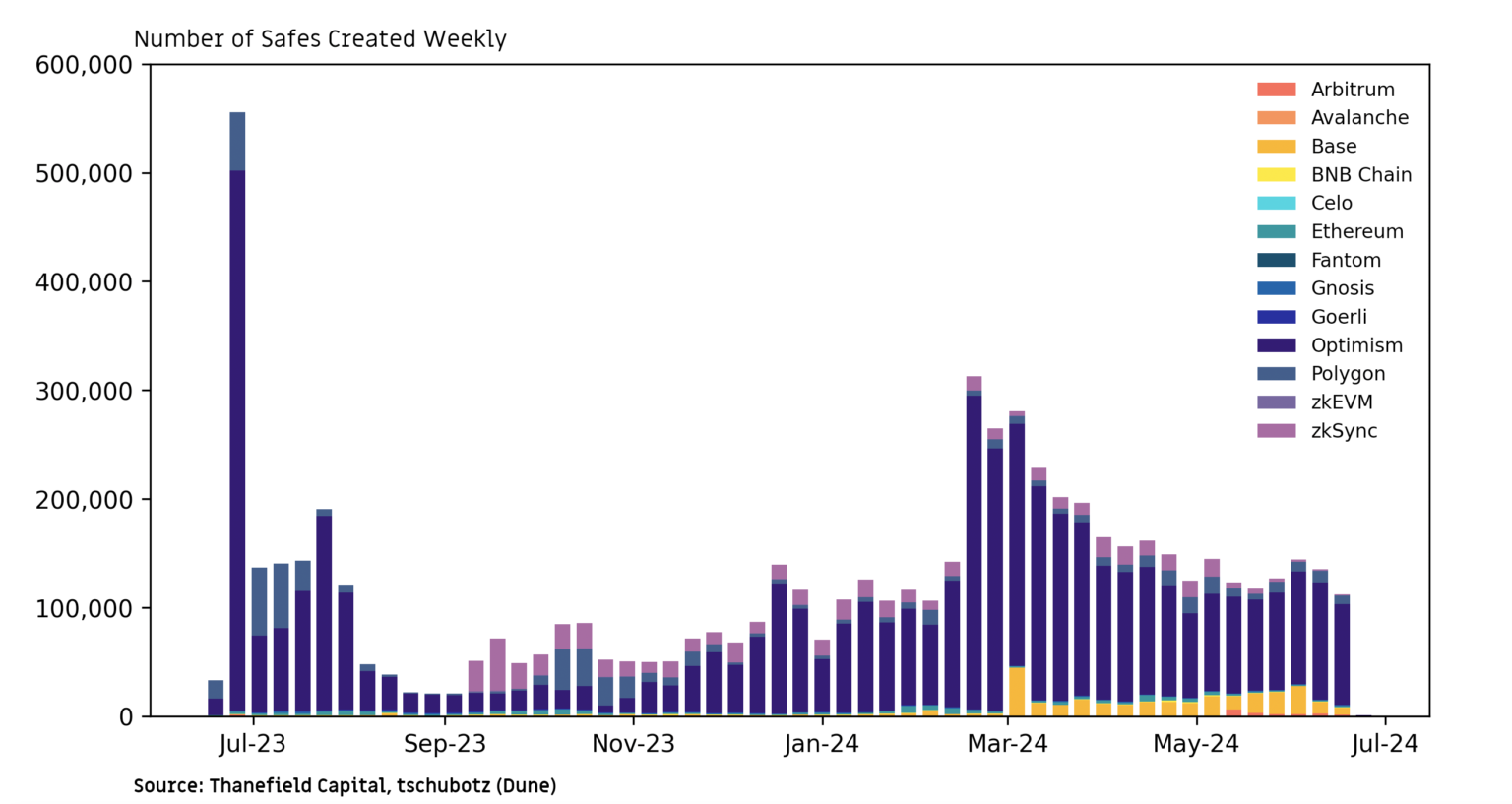
Safe has a modular architecture. Core components are integrated into the battle-tested Safe{Core} stack, while Safe modules introduce custom features and enhance overall functionality. This modular approach is similar to the hooks used in Uniswap v4, and the Safe module ensures strong security at the core layer and simplifies customization and integration for developers. Developers can create modules to meet specific needs or integrate existing modules. For example, users can add or remove modules that facilitate password key authentication or manage quotas. In addition, Safe includes an ERC-4337 module, making it compatible with this newer account abstraction standard and its related infrastructure.
ERC-4337
ERC-4337 is the standard currently used on Ethereum and most EVM chains, and was implemented on the Ethereum mainnet in March 2023. It serves as an intermediate step in the evolution of account abstraction and does not require modifications to the consensus layer protocol to implement. Instead, it utilizes a concept called pseudo-transactions (user actions) that are based on intent and combine on-chain and off-chain infrastructure to facilitate and execute these actions.
ERC-4337 brings significant improvements to the user experience:

ERC-4337 Transaction Process
ERC-4337 introduces a new transaction flow without changing the consensus layer. This approach integrates some infrastructure components that make it different from the traditional EOA transaction cycle. The main difference is the steps before the transaction is signed, while the process remains the same afterwards. Key elements include UserOps, paymasters, alt mempools, bundlers, and EntryPoint contract.
In the ERC-4337 transaction cycle, users express their intention to perform specific operations on the chain through UserOps, rather than signing transactions directly. UserOps are managed in the alternative memory pool (Alt mempool), which is dedicated to handling UserOps and is different from the public memory pool. Bundlers, similar to block builders, monitor the alternative memory pool and select UserOps to include in their bundles based on the priority fee. These bundles are signed by bundlers and submitted to the EntryPoint contract, a global contract on Ethereum dedicated to all ERC-4337 operations, for execution. If necessary, Paymasters can sponsor transactions or pay gas fees using ERC-20 tokens. After that, transactions are carried out and executed on the chain in the usual way.
To see a visual representation of this process, this diagram from Blocknative is very helpful:

ERC-4337 adoption
Since its deployment in 2023, ERC-4337 has been widely adopted on Layer 2 solutions and sidechains, especially on Base and Polygon. To date, more than 5.5 million ERC-4337 wallets have been established, with an average of about 800,000 successful user operations per week.
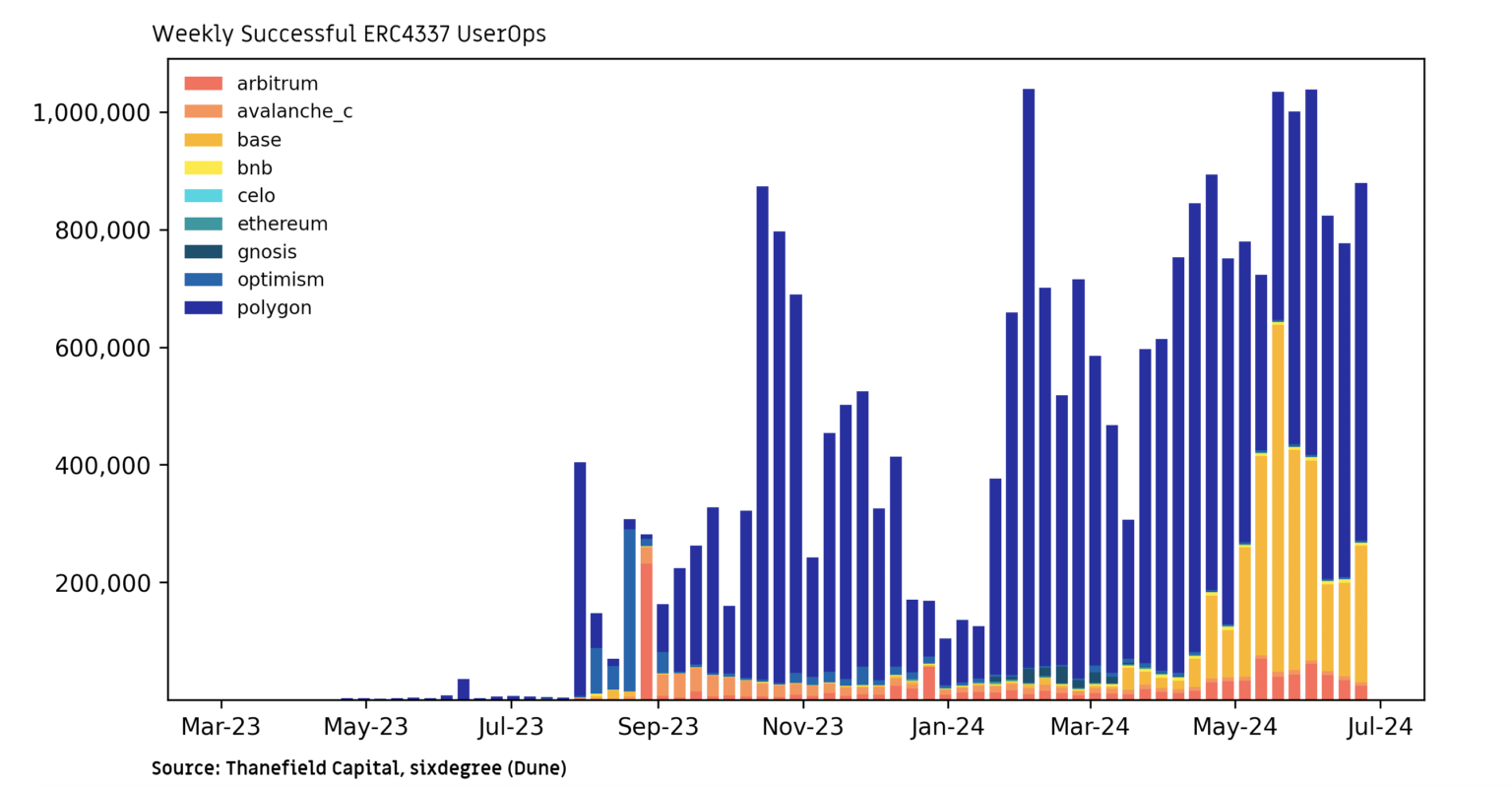
Coinbase is at the forefront of driving the development and adoption of smart wallets. On June 5, Coinbase launched Coinbase Smart Wallet , a new product that uses the ERC-4337 standard. This smart wallet offers several notable features, including password-key authentication, sponsored transactions for selected dApps on Base, and multi-account ownership capabilities. With Coinbases strategic focus on bringing new users to the Base platform, smart wallets are likely to quickly become the dominant wallet type on Base. Biconomy , Pimlico , และ การเล่นแร่แปรธาตุ are also emerging in providing key components of the ERC-4337 infrastructure, especially in terms of packagers and payment masters. The following table shows the dominance in terms of the number of user actions performed and paid.

Despite these encouraging data, ERC-4337 wallets have yet to achieve widespread adoption on the Ethereum mainnet, with only two to three hundred active wallets per week. Safe wallets remain the dominant standard for smart wallets on Ethereum. One of the main limitations of the ERC-4337 design is that it does not allow existing EOA wallets to be converted to smart wallets. In addition, the relatively high gas fees on the Ethereum mainnet make certain features, such as sponsored transactions, economically infeasible.
อีไอพี-7702
Following ERC-4337, EIP-7702 takes a significant step towards fully native account abstraction. Drafted by Vitalik Buterin, the proposal quickly emerged as a response to the controversial EIP-3074, which had issues with compatibility with the future EIP in the Ethereum Account Abstraction (AA) roadmap. Unlike ERC-4337, which operates at the infrastructure level, EIP-7702 proposes changes directly at the protocol level. The proposal is expected to be included in the upcoming Pectra upgrade, which is expected to be between Q4 2024 and Q1 2025.
EIP-7702 is considered one of the most important UX improvement proposals in Ethereums history. It enhances the ERC-4337 framework by introducing key features such as transaction batching, gas sponsorship, and temporary permissions for EOAs. Specifically, it introduces a new type of transaction that allows EOAs to temporarily adopt smart contract code during a transaction and revert to the original state after the transaction is completed. The proposal ensures forward compatibility with existing ERC-4337 implementations and is aligned with the long-term goals of the Ethereum AA roadmap.
Case Study: Worldcoin
Worldcoin is developing a protocol called Human Authentication that aims to enable applications to verify that users are real humans and not AI-driven robots. This verification is achieved through the World ID , a digital passport issued to users after their irises are scanned using Orbs (a specialized device). Once obtained, the World ID can be used as a universal verification tool for a variety of applications and services. In addition to identity verification, users can also receive biweekly WLD grants, which are distributed on-chain.
Worldcoin has successfully issued over 4.5 million World IDs, allowing users to verify their identity without any prior knowledge of blockchain technology. Upon registration, the World App automatically generates a Safe smart wallet on the Optimism network for each user in the background. This process completely abstracts the blockchain layer, providing a user experience similar to Web2 features such as facial authentication, social recovery, and detailed account management.
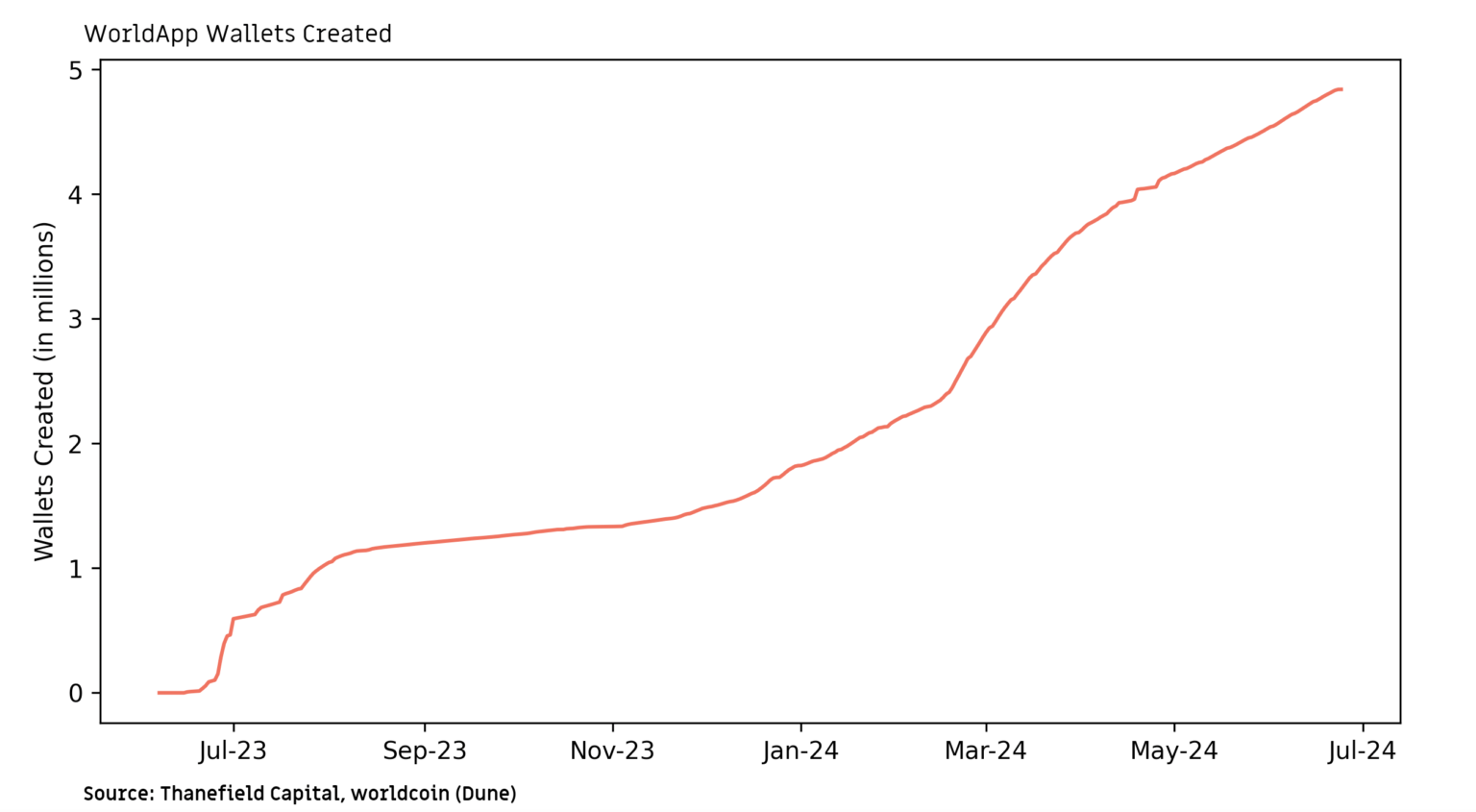
Both WLD grants and World IDs are stored in a self-custodial manner, ensuring that users retain control of their digital assets. In the case of Worldcoin, Safe-powered Smart Accounts enable users to gain the benefits of self-custody and economic incentives provided by cryptocurrencies while enjoying a Web2-like user experience. As a result, Web3 adoption has been impressive, with a large number of first-time Web3 users joining the Web3 space.
Interoperability, Liquidity Aggregation, and Intent
With Ethereum鈥檚 rollup-centric roadmap and the popularity of application-specific chains, the number of different blockchain platforms will increase rapidly. This expansion emphasizes the necessity of strong cross-chain communication.
Some ecosystems have developed native interoperability solutions that provide standardized security models and achieve a degree of chain abstraction within their domain. Notable examples include Polkadots shared security architecture and Cosmos IBC protocol. In the context of rollups, synchronous cross-chain messaging and atomic cross-chain interactions can be achieved through the use of a shared sorter, which is responsible for processing and ordering transactions and managing state. For example, Optimism has adopted this approach for its Superchain vision.
Despite these advances, cross-chain communication, especially outside of these established ecosystems, remains a significant challenge due to the lack of native interoperability and widespread standardization. In this section, we will explore various architectural designs for interoperability in terms of chain abstraction. In addition, we will highlight leading projects in each vertical, showing how they are advancing the development of blockchain connectivity.
Messaging system
The classic approach to blockchain interoperability is to leverage a general-purpose messaging system, typically relying on a set of external validators. In this design, users specify the desired outcome, and off-chain entities construct a precise execution path across multiple chains. This path is executed by a coordinated set of smart contracts and relayers. However, achieving atomic execution across multiple chains is inherently challenging as each chain continuously generates blocks and changes its state. Even with a strong data availability layer to maintain the state of all integrated chains, there are significant complexities in navigating routes through multiple chains.
The design and architecture of messaging systems vary widely. They can be modular or monolithic, permissioned or permissionless, support a variety of chains, and operate based on minting and burning mechanisms or liquidity pools. Developers face numerous trade-offs when creating chain abstraction stacks to choose messaging systems to integrate, each offering different levels of security guarantees and user experience. This diversity in design and functionality can hinder the adoption of common standards, leading to further fragmentation in the field.
Currently, cross-chain aggregators such as Li.Fi and Socket use a simple messaging system. These platforms integrate with numerous bridges and DEXs to simulate suggested routes for users. Once a route is chosen, it will be executed in a strict order.
Intent-based design
In intent-based interoperability design, users only need to express the desired outcome, rather than specifying a specific execution path as in traditional blockchain transactions. These intents are auctioned off to Solvers (off-chain entities), who bid for the right to execute them. The specific solutions to the intents are not important; they can be partially or fully matched, or filled from the Solvers own inventory. In this system, users specify the outcome, and experts compete to provide the best execution solution.
A key advantage of this approach, especially in the context of cross-chain asset transfers, is that it deals directly with native tokens rather than IOUs, thereby providing native security guarantees and enhancing overall security. Currently, intent-based applications mainly exist in bridges (such as Across และ Synapse ) and decentralized exchanges (such as Cow Swap , Uniswap X , และ 1inch Fusion ).
Recently, Across and Uniswap collaborated to propose the cross-chain intent standard ERC-7683 , which is the first attempt to create an intent-based system to regulate a unified framework for cross-chain operations. Other notable developments include Socket鈥檚 recent release of a new version focused on cross-chain modular order flow, and Everclear (formerly Connext) announced intent-based primitives that leverage solver networks and EigenLayer-based Optimistic Rollup to manage liquidity between blockchains.
However, implementing intent-based solutions faces significant challenges. First, users need access to a cross-chain account – a smart account that manages keys in the background and enables cross-chain transactions. In addition, standardization is also a major obstacle; currently, each intent-based application must independently develop its infrastructure, including intent aggregation, matching, and auction models. This lack of standardization has led to fragmentation and inefficiency in the entire ecosystem.
Chain abstraction is a concept without a technical specification, so it can be approached from many different angles. In our opinion, some of the most interesting attempts include Anoma鈥檚 intent-centric architecture, Polygon鈥檚 aggregation layer, and NEAR鈥檚 full-stack chain abstraction solution. We will explore these attempts in depth.
Case Study: Anoma
Anoma is a privacy-focused, intent-based protocol designed to enable decentralized counterparty discovery, resolution, and atomic multi-chain settlement. The platform is architecturally unique: unlike traditional blockchain systems, which require users to specify the execution flow, Anoma only requires users to define the final state they are willing to accept, expressed through programmatic commitments called intents. What is unique about Anoma is that these intents are composable and can be resolved collectively, regardless of their source.
Anoma鈥檚 transaction architecture includes the following steps:
-
Generic Intents : Anoma is architected to handle arbitrary intents, not limited to specific applications or special cases. This flexibility allows for a wide range of applications and interactions.
-
Counterparty Discovery : This is a decentralized process where individual intents are propagated across the network, making them accessible to potential solvers.
-
Solving : In this phase, solvers collaborate to combine and compute intent to find a valid solution, i.e. a transaction that can be executed and settled across chains.
-
การตั้งถิ่นฐาน : Resolution is verified and finalized on-chain. Anoma鈥檚 intent-centric architecture supports settlement on its own sovereign L1 chain, other L1 chains, or any rollup that settles on L1.

Case Study: Polygon AggLayer
Polygons AggLayer is a zero-knowledge (ZK) proof-based system designed to solve the interoperability and fragmentation issues between different rollups and Layer 1 (L1). By aggregating ZK proofs from all participating chains, this approach provides unified cryptographic security and atomic composability.
AggLayer brings the connected environment to Ethereum through a unified bridge contract. Each connected chain maintains a copy of this unified bridge root, enabling seamless cross-chain transactions. In addition, AggLayer also features a message protocol bridge that establishes a message queue for each chain, allowing them to maintain a local outbound message queue protected by ZK proofs. This eliminates the need to lock tokens on one chain to interact with another chain. By publishing ZK proofs of events across multiple chains on Ethereum, AggLayer achieves a seamless user experience similar to a single ecosystem.
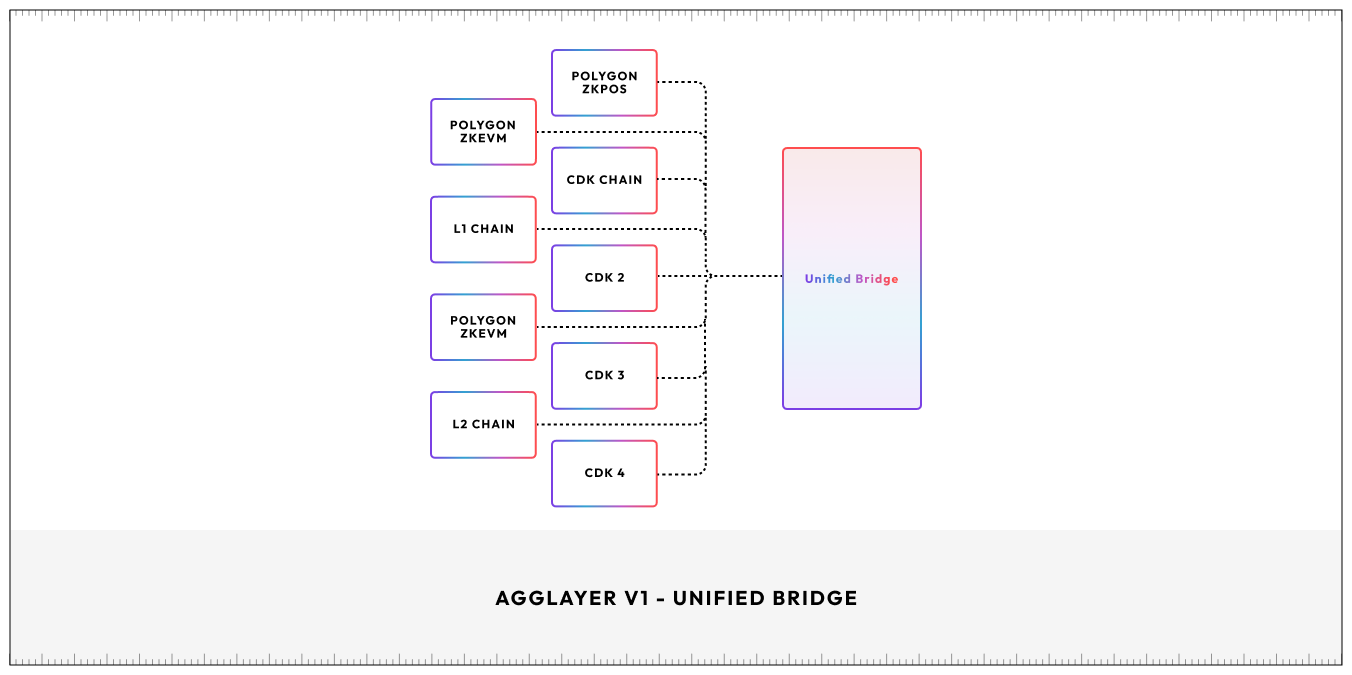
รูปหลายเหลี่ยม CDK allows projects to launch ZK-based interconnected L2s or connect existing L1s to AggLayer, maintaining liquidity, users, and status. The first component of AggLayer went live in February 2024, marking an important step for Polygon in creating an aggregated network of sovereign chains.
Case Study: NEAR Chain Abstraction Stack
NEAR is developing a comprehensive chain abstraction stack for its blockchain and its surrounding ecosystem. The stack includes the following components:
-
Security aggregation stack : This part includes NEAR DA (data availability), which collects the status of supporting chains. In addition, it integrates zkWASM developed in cooperation with Polygon and uses the fast finality provided by EigenLayer to increase transaction processing speed.
-
Account aggregation : Based on multi-party computation (MPC), this component enables NEAR accounts to interact with external blockchains by requesting signature verification. The private keys of these third-party chain accounts are managed by the validators of the NEAR network as a decentralized signature service. This setup effectively binds accounts from different networks to a central NEAR master account that can securely manage all associated accounts.
-
Intent Layer : This layer contains relayers that execute complex cross-chain intents, facilitating more complex transactions and interactions across blockchain networks.
-
ชั้นแอปพลิเคชัน : This layer integrates various web3 services into a user-friendly application, simplifying access and interaction with decentralized technologies.
Shown below is a visual representation of NEAR鈥檚 account aggregation architecture :
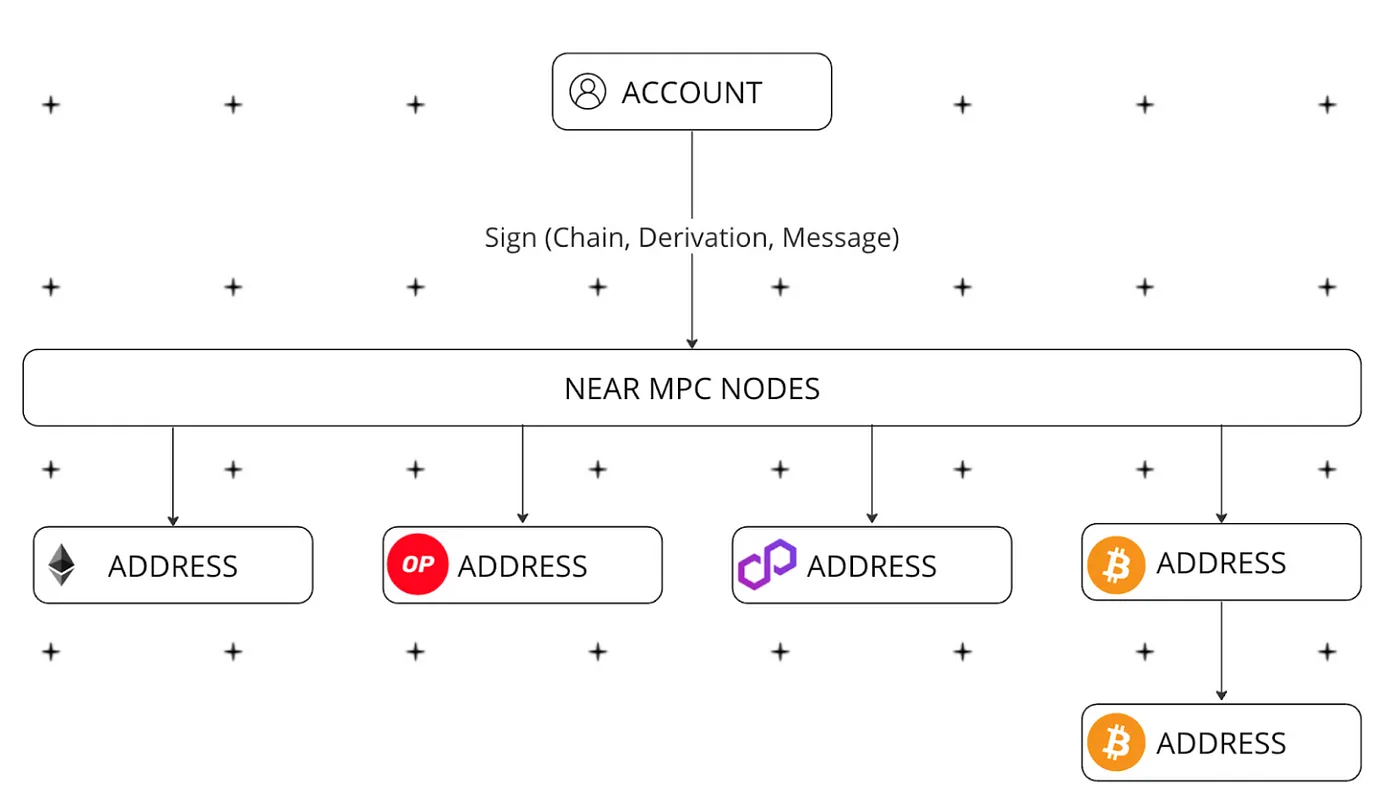
เลเยอร์แอปพลิเคชัน
Looking back to the past, the application layer is the final stage of chain abstraction, where the infrastructure is integrated and presented consistently to developers and users.
In an ideal world, developers can easily build protocols that are not dependent on a specific blockchain without having to integrate various modular layers, which can reduce a lot of work. This means that developers do not need to consider the choice of blockchain, the management of cross-chain liquidity, and the choice of data availability solutions.
From a users perspective, the ideal state is that interacting with blockchain applications is as smooth as using other digital services, without having to consider the hassles associated with encryption, such as gas fees and seed phrases. This requires simplifying the user interface, optimizing the onboarding process, and eliminating the need for users to understand the underlying technology, which are currently major obstacles. Removing these obstacles will significantly improve the user experience and promote mass adoption.
Before this vision can be realized, tools need to be developed to integrate different infrastructures into a unified interface. Therefore, we believe that chain abstraction is essential for a good user experience.
Whoever masters the front end will have the most direct connection with users and be able to extract the most value from their order flow. While most of the attention and investment is currently focused on infrastructure, we believe that in the future the focus will shift to higher layers of the stack.
สรุปแล้ว
There are currently nearly 300 chains with significant liquidity and on-chain representation, from Layer-1 to Layer-3 solutions. This number is constantly growing and shows no signs of slowing down.
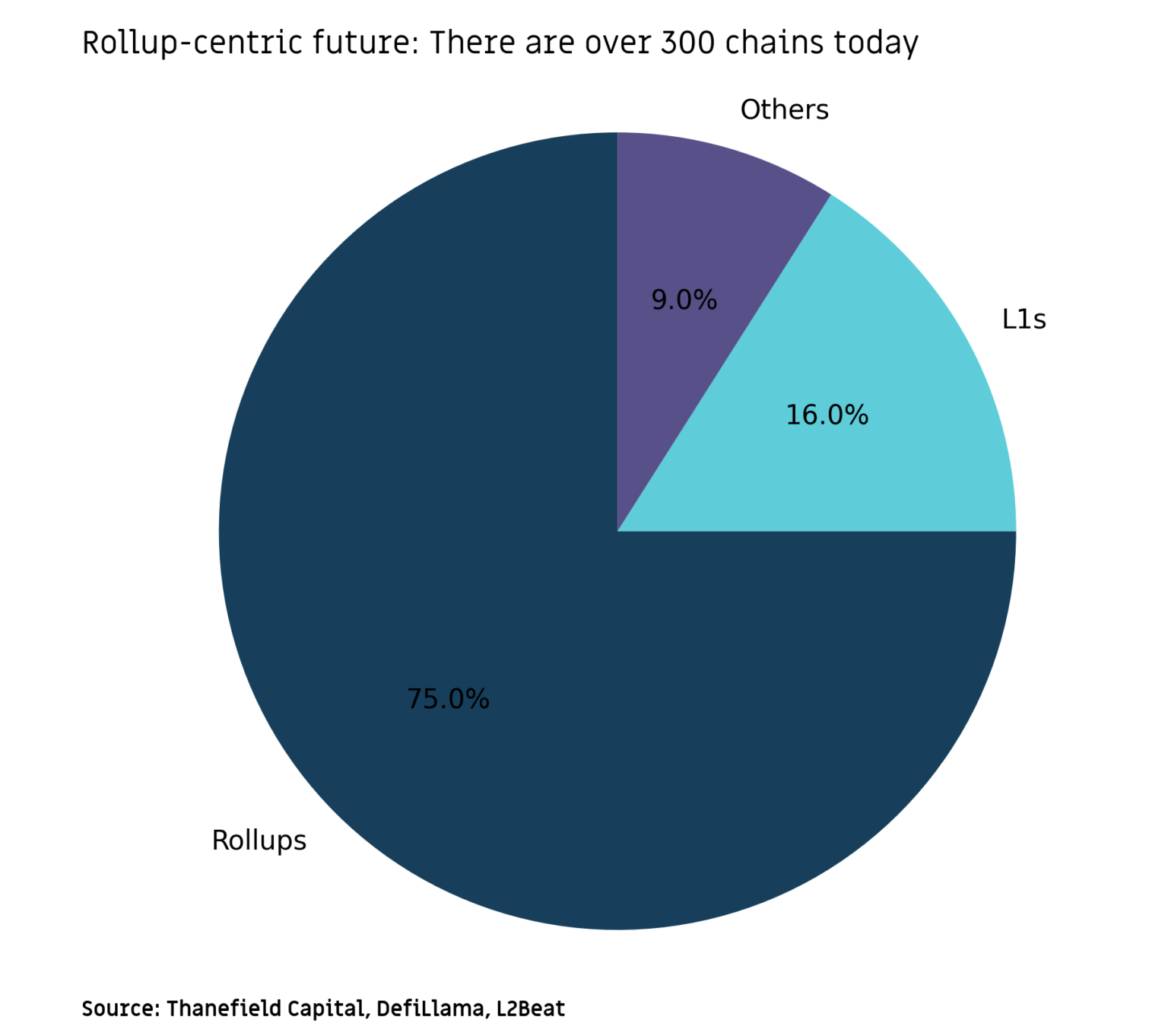
One of the main reasons driving this growth is the demand for scalability and sovereignty from applications, which can be achieved by having their own execution stack and economic system. For example, recently ส.ส , อาฟ , และ ดีดีเอ็กซ์ launched their own rollups. Open source technologies like OP Stack also make it cheaper and easier to build, deploy, and operate rollups, and Rollup-as-a-Service providers like Conduit และ Caldera further reduce operational and technical overhead. Ironically, it is often cheaper to deploy a rollup today than to trade on Ethereum during the 2021 cycle.
For today鈥檚 users, managing cryptocurrency is already often confusing and cumbersome, involving tasks such as securing seed phrases, signing multiple transactions for simple tasks, handling assets on different chains, bridging these assets, and finding the best prices on various DEXs. While rollups offer the potential to scale without sacrificing security and decentralization, their popularity adds complexity from both a user and developer perspective. A simplistic implementation would only make the user experience worse.
Modern chain abstraction tools solve this problem, making cryptocurrency simpler and more viable for a wider audience. The winners in this space will capture a ton of value due to the proximity of these tools to users. As on-chain applications generate more and more revenue, the market will recognize the importance of owning the front end.
This article is sourced from the internet: The blockchain abstraction trend is on the rise, a quick guide to technology and ecology
Related: Get the latest information on Sanctum tokens and airdrops
Original daily Planet Daily Author: Azuma On June 5th, Beijing time, Solana ecosystem LST staking protocol Sanctum officially announced basic information about the token economic model, and explained some detailed plans about the points activities and airdrop plans through subsequent community AMA. As the top project in the second phase of Jupiter LFG Launchpad voting, Sanctum has always received high community attention in the Solana ecosystem. In the past one or two months, Sanctum has achieved rapid growth in data with the help ofthefirst season points eventSanctum Wonderland S 1.As of the time of writing, the TVL is temporarily reported at US$1.03 billion, making it the fourth DeFi protocol in the Solana ecosystem in terms of TVL. Project Analysis In April, Sanctum announced the completion of its seed round of…







